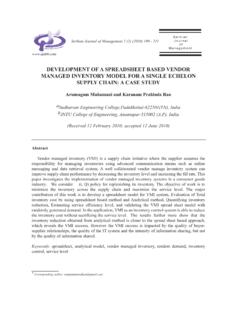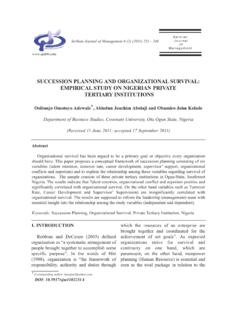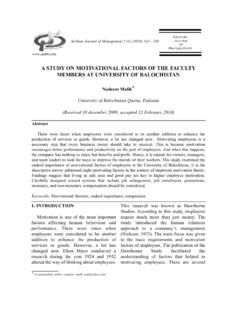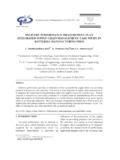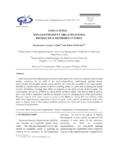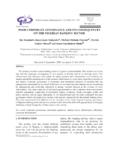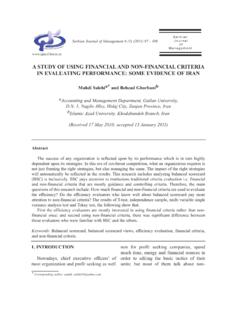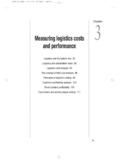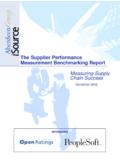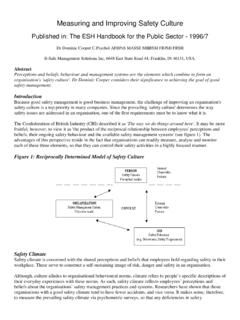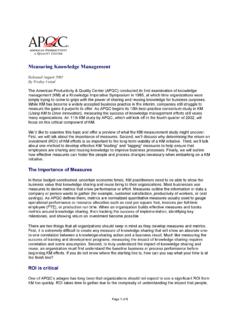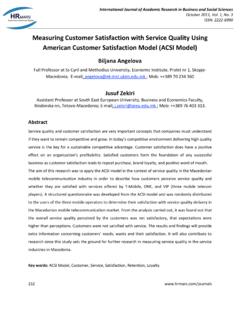Transcription of MEASURING PRODUCTIVITY OF SOFTWARE …
1 1. INTRODUCTIONThe objective of IT function for anyorganization is to achieve operationalefficiency, reduce costs on repetitive tasks,reduce response time of the customer,achieve consistency, reliability and accuracyin customer transactions so that customersatisfaction can be improved. In achievingthis, the organization forms project teams, MEASURING PRODUCTIVITY OF SOFTWARE DEVELOPMENT TEAMSG oparaju Purna Sudhakara*, Ayesha Farooqband Sanghamitra PatnaikcaEngineering Staff College of India, Gachibowli, Hyderabad, , India, 500034bAligarh Muslim University, Aligarh, , IndiacAdvanced Centre for American Studies (ACAS), Osmania University Centre forInternational Programmes (OUCIP), Osmania University, Hyderabad, , India(Received 20 November 2010; accepted 26 September 2011)AbstractThis paper gives an exhaustive literature review of the techniques and models available tomeasure the PRODUCTIVITY of SOFTWARE development teams.
2 Definition of PRODUCTIVITY , measuringindividual programmer s PRODUCTIVITY , and MEASURING SOFTWARE development team PRODUCTIVITY arediscussed. Based on the literature review it was found that SOFTWARE PRODUCTIVITY measurement canbe done using SLOC (Source Lines of Code), function points, use case points, object points, andfeature points. Secondary research findings indicate that the team size, response time, taskcomplexity, team climate and team cohesion have an impact on SOFTWARE development teamproductivity. List of factors affecting the SOFTWARE development team PRODUCTIVITY are studied : SOFTWARE PRODUCTIVITY , Team PRODUCTIVITY , PRODUCTIVITY Factors, SOFTWARE Teams,Managing Information Systems Projects*Corresponding author: Journalof ManagementSerbian Journal of Management 7 (1) (2012) 65 - 75 : functional teams to meet theorganizational objectives. More than 70% ofthe Fortune 500 organizations have teams intheir organizations.
3 Particularly softwaredevelopment is done by teams inorganizations. Onsite, offshore teams, virtualteams, globally distributed teams, highperformance teams, and self managed teamsare some of the terminology we hear insoftware industry in current days. Theobjective of any SOFTWARE businessorganization is to achieve maximum teamproductivity to reduce costs and to increaseprofitability. With the advent of processmaturity models such as CMMI and PCMM, SOFTWARE services organizations in Asiancountries are even thriving for continuousimprovement. The definition of DEFINITION OF PRODUCTIVITYT raditionally PRODUCTIVITY can be definedas a ratio of output units produced to theinput units of effort (Scacchi, 1995;Maxwell, 2001; Wagner & Ruhe, 2008a;Nwelih & Amadin, 2008). Output units canbe the number of lines of source code andinput units can be the person months of the lines of code (LOC) or theFunction Points are used for measurement ofproductivity in SOFTWARE development(Wagner & Ruhe, 2008a).
4 According toWagner and Ruhe (2008a), the number oflines of code written or the number offunction points implemented per man hourby the developer is used as a measure ofproductivity. Previous SOFTWARE teamproductivity studies were conducted inorganizations such as IBM, NASA, ITT, andHP. According to Nwelih and Amadin(2008), SOFTWARE PRODUCTIVITY definitionincludes complexities of both SOFTWARE andpeople. According to them softwareproductivity can be calculated by dividingsoftware size with cost of to Card (2006), PRODUCTIVITY isdefined as the ratio of outputs produced tothe resources researchers like Albrecht (1979)have developed Function Points at IBM andJones (1986) has studied the PRODUCTIVITY andquality of the SOFTWARE projects. Jones (1986)work on PRODUCTIVITY is published in hispopular book Programming Lakhanpal (1993) has studied thecharacteristics of groups and their impact onproductivity (Wagner & Ruhe, 2008a).
5 Studyof SOFTWARE development team productivityinvolves disciplines such as SoftwareEngineering, Management andOrganizational Psychology. Banker, Datarand Femerer (1991) have studied thevariables impacting the PRODUCTIVITY ofsoftware maintenance projects with the helpof an empirical study of 65 softwaremaintenance projects of a large WHY MEASURE TEAMPRODUCTIVITY?According to Scacchi (1995), Softwareteam PRODUCTIVITY is to be measured toreduce the SOFTWARE development costs, toimprove the quality of deliverables, and toincrease the rate at which SOFTWARE is to bedeveloped. According to him, the softwareproductivity is to be measured to recognizethe top performers to reward and identify thebottom performers to provide the major PRODUCTIVITY improvements canresult into substantial amount of savings indevelopment costs (Scacchi, 1995).66G. P. Sudhakar / SJM 7 (1) (2012) 65 - 75 MEASURING PRODUCTIVITY helps in identifyingunder utilized resources (Nwelih & Amadin,2008).
6 The study of SOFTWARE PRODUCTIVITY isimportant because higher PRODUCTIVITY leadsto lower costs (Bouchaib & Charboneau,2005). Bouchaib and Charboneau (2005)have studied the comparison of productivityof in-house developed projects andproductivity of outsourced projects to thirdparty with a sample of 1085 projectsdeveloped , Kriebel, Kekre andMukhopadhyay (1999) have studied thesoftware life cycle PRODUCTIVITY , whichincludes both development and maintenancecosts and drivers of SOFTWARE teamproductivity and quality such as personnelcapability, product size, usage of tools andsoftware process factors. According toBanker and Kauffman (1991), softwareproductivity can be found from the = (Size of ApplicationDeveloped) / (Labor consumed duringdevelopment) (1)4. MEASURING INDIVIDUALPROGRAMMER S PRODUCTIVITYA ccording to Wagner and Ruhe (2008), SOFTWARE PRODUCTIVITY can be measuredtraditionally using the lines of code orfunction points and the PRODUCTIVITY is theLOC or FP produced per hour by theprogrammer.
7 The PRODUCTIVITY and costestimation model COCOMO developed byBoehm (1981) also considers the individualprogrammer s PRODUCTIVITY as a decisive factors identified by Barry Boehm andteam which affect SOFTWARE PRODUCTIVITY andcost include programmer capability, teamcohesion, platform experience,programmer s programming languages andtools experience, SOFTWARE applicationsexperience, and analyst goals to the programmer,providing training, giving periodic feedbackon his or her performance improves theindividual PRODUCTIVITY of programmer(Wagner & Ruhe, 2008). According toChiang and Mookerjee (2004), improvingsoftware development PRODUCTIVITY dependson people, technology and constraints which control theprogrammer PRODUCTIVITY are the timeconstraints, financial constraints, softwarespecifications, corporate environment andprogramming methodology (Vyhmeister,1996). According to Vyhmeister (1996), onecan use Lines of code (LOC), FunctionPoints (FPs), and Object points (OPs) tomeasure the PRODUCTIVITY of programmer s PRODUCTIVITY canvary between 1 to 10 times in the sameexperience level programmers and teamproductivity can have variations of a factorof 5 (White, 1999).
8 People related issues arethe critical factors of individualprogrammer s to M. Pinkowska, teamproductivity is dependent on individual teammember s PRODUCTIVITY and the teammember s experience of success impacts hisor her motivation, team cohesiveness andwork atmosphere. Teams with highcohesiveness exhibit lower tension andanxiety, less variations of PRODUCTIVITY ,improved team member satisfaction,improved team communication, andcommitment. Team members in cohesiveteams enjoy team membership, experiencelow personnel turnover, and they are veryproductive (M. Pinkowska s Research).67G. P. Sudhakar / SJM 7 (1) (2012) 65 - 7568G. P. Sudhakar / SJM 7 (1) (2012) 65 - 75 Table 1. Techniques/Models for MEASURING SOFTWARE Development Team ProductivitySl. No: Technique/Model Formula/Description High Lights Reference 1. Team PRODUCTIVITY (P) P = Kilo Lines of Code/ Person months of effort Further given the needed staff size as person months of effort divided by project time duration in months Tausworthe (1982) 2.
9 Measurement model Analysis/Design Activity Output measure = Function Points Coding/Testing Activity Output measure = Source Lines of Code Input Measure = Total Labor hours This model considers Function Points, SLOC, environmental variables, and any deviations from the project. Banker, Datar and Kemerer (1991) 3. PRODUCTIVITY Model and Cost Model Mathematical Models This Model explains the impact of interaction of team members and team size on team PRODUCTIVITY and project cost. Tockey (1996) 4. Model of Life Cycle PRODUCTIVITY and Quality Quality = f1(Personnel Capability, Usage of Tools, Product Size in LOC, PROCESS, Front End Resources) Life Cycle PRODUCTIVITY = f2(Conformance Quality, Personnel Capability, Usage of Tools, PROCESS) Life Cycle PRODUCTIVITY = Product size in LOC / Total cost incurred in Product development and support.
10 This model considers variables such as personnel capability, quality, SOFTWARE process, product size in LOC, Front End Resources and Usage of tools. Krishnan, Kriebel, Kekre and Mukhopadhyay (1999) 5. Model of Correlated Team Behavior SOFTWARE Team PRODUCTIVITY = KLOC per Calendar month. Provides a simulation model which supports correlated team behavior. Potok and Vouk (1999) 6. Productive Ratio ( ) = % of Direct Development time / % of Idle time The model suggested considered PRODUCTIVITY , requirements volatility and complexity. Nogueira, Luqi, Berzins and Nada (2000) 7. PRODUCTIVITY Model PRODUCTIVITY = Number of Function Points / Effort in Man months This model considers the factors such as Experience of Project Manager, size, requirements ambiguity, complexity, stable standards, user requirements, usage of tools, etc.

